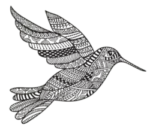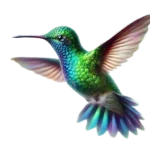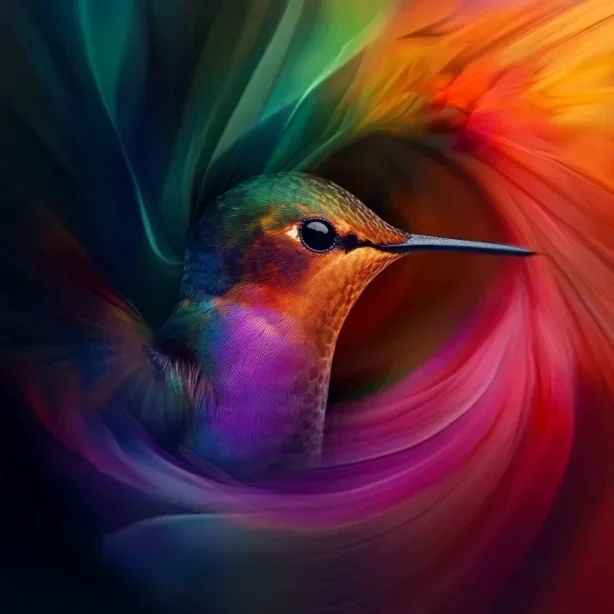(Or: How to See the World Through Nature’s Most Sophisticated Eyes)
Imagine living in a world where colors don’t just stop at the rainbow’s edge – where ultraviolet patterns dance across flowers like neon signs, and subtle color variations appear as distinct as black and white. This isn’t science fiction; this is the daily reality for hummingbirds, whose color perception makes human vision look like an old black-and-white television.
Let’s start with some visual capabilities that make neuroscientists question everything they thought they knew about color perception:
- Can see into the ultraviolet spectrum
- Process four primary colors (humans have three)
- Distinguish colors humans can’t even imagine
- Detect color variations in microseconds
- Process visual information faster than most computers
The Fourth Dimension of Color
While humans pride themselves on their color vision, hummingbirds operate in an entirely different league. Their eyes contain a fourth type of cone cell that allows them to see into the ultraviolet spectrum, creating a visual experience we can barely comprehend. It would be like suddenly discovering a new primary color that makes all other colors look different.
This fourth dimension includes:
- UV-sensitive cone cells
- Combination UV-color perception
- Non-spectral color vision
- Enhanced pattern recognition
- What amounts to nature’s most sophisticated color detection system
The Speed of Sight
Not only do hummingbirds see more colors, but they also process visual information at rates that would make a high-speed camera jealous. Their visual processing speed is crucial for their high-velocity lifestyle, allowing them to navigate and feed with incredible precision.
Their rapid vision processing enables:
- Real-time flight adjustment
- Instant flower recognition
- Rapid predator detection
- Motion tracking in all directions
- Split-second decision making
The Flower Recognition System
For hummingbirds, flowers aren’t just pretty decorations – they’re complex visual advertisements complete with ultraviolet landing strips and nectar quality indicators invisible to human eyes. Their sophisticated color perception allows them to read these floral billboards with remarkable precision.
Flower vision features include:
- UV pattern detection
- Nectar quality assessment
- Age indication recognition
- Pollination status identification
- Resource value evaluation
The Navigation Network
Color perception plays a crucial role in hummingbird navigation, helping them create detailed mental maps of their environment that include information we can’t even perceive.
Navigation capabilities include:
- Landmark color memory
- UV-guided path finding
- Seasonal change detection
- Territory boundary recognition
- Resource location mapping
The Communication Channel
Colors serve as a sophisticated language in the hummingbird world, conveying messages about everything from mate quality to territory ownership.
Visual communication includes:
- Iridescent signal flashing
- UV pattern displays
- Territorial color markers
- Breeding condition signals
- Social status indicators
The Predator Detection System
Enhanced color perception serves as a crucial survival tool, helping hummingbirds spot potential threats before they become immediate dangers.
Security features include:
- Movement pattern detection
- Camouflage penetration
- Shadow recognition
- Rapid threat assessment
- Environmental change awareness
The Memory Matrix
Hummingbirds don’t just see amazing colors – they remember them with extraordinary precision, creating detailed mental catalogs of their visual world.
Memory capabilities include:
- Color pattern recognition
- Resource quality association
- Location-color mapping
- Seasonal change tracking
- Individual flower memory
The Energy Efficiency Game
Advanced color perception requires significant energy investment, and hummingbirds have evolved sophisticated systems to manage this resource demand.
Energy management includes:
- Selective attention patterns
- Priority processing systems
- Visual information filtering
- Neural efficiency optimization
- Resource allocation strategies
The Learning Laboratory
Each new visual experience adds to a hummingbird’s understanding of their world, creating an ever-expanding library of color-based knowledge.
Learning adaptations include:
- Pattern recognition refinement
- Experience-based adjustment
- Novel stimulus integration
- Visual preference development
- Color association building
The Future View
As environments change, hummingbird color perception continues to adapt, helping these remarkable birds navigate an ever-changing world.
Future adaptations may include:
- Urban light adaptation
- Artificial color recognition
- Novel pattern processing
- Changed habitat navigation
- Enhanced threat detection
Conclusion: Nature’s Visual Virtuosos
The color perception capabilities of hummingbirds represent one of nature’s most sophisticated achievements in visual processing. These tiny birds literally see our world in ways we can only imagine.
Remember: When you watch a hummingbird precisely navigate to a specific flower, you’re witnessing a creature operating in a visual realm far beyond human perception, reading a world written in colors we’ll never see.
Post Script: Some vision scientists suspect hummingbirds might be secretly laughing at our limited color perception. The birds maintain their usual diplomacy about such matters, but their precise navigation of complex visual environments suggests they might know something about color that we’re still trying to figure out.


